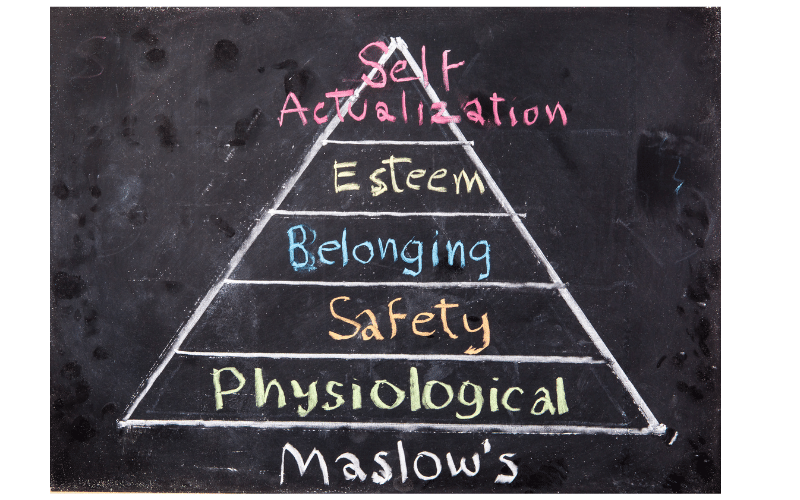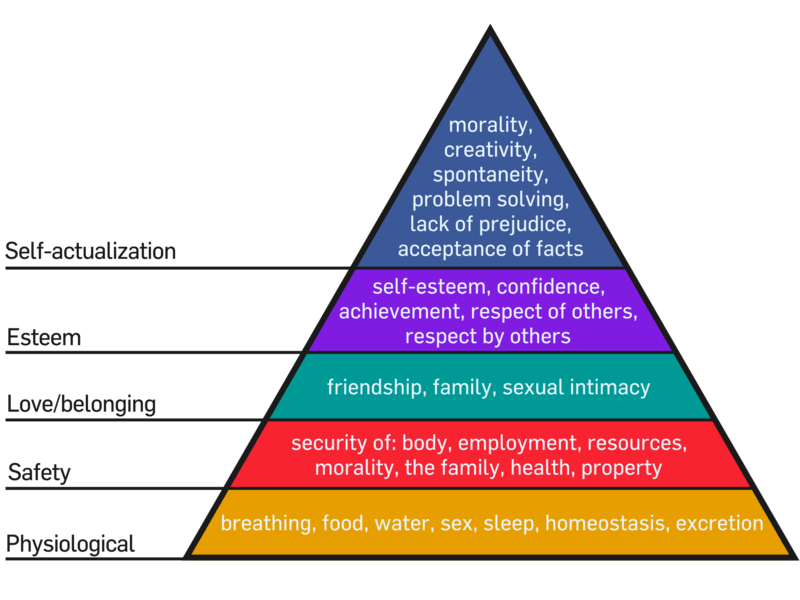Maslow’s Hierarchy of Needs Explained
From basic survival to self-actualization, Maslow’s hierarchy reveals how our deepest needs shape the way we live, work, and pursue happiness.

Maslow’s hierarchy of needs is a theory of human motivation suggesting that behaviors are driven by increasingly complex needs. The hierarchy is usually depicted as a pyramid. The most basic needs make up the base, and complex needs are found at the peak.
The five levels of the hierarchy of needs are:
- Physiological Needs
- Safety Needs
- Social Needs
- Esteem Needs
- Self-Actualization Needs

The purpose of Maslow’s hierarchy of needs is to provide a framework for understanding human motivation and behavior.
Maslow believed that human needs are arranged in a hierarchy, with lower-level needs serving as a foundation for higher-level needs. He proposed that individuals are motivated to fulfill their basic needs first before moving on to higher-level needs and that the fulfillment of these needs contributes to overall well-being and self-actualization.
Let’s take a closer look at the hierarchy and how it explains motivation.
5 Levels of Maslow’s Hierarchy of Needs
Maslow’s hierarchy of needs is most often depicted as a pyramid. This suggests that the base-level needs must be met before an individual can move upwards to higher-level needs.
Key facts about the hierarchy of needs:
- People are motivated to fulfill certain needs
- Some needs take precedence over others
- Basic needs must be met first
- Lower-level needs arise from deprivation
- Needs become increasingly complex as you move up the hierarchy
- Higher-level needs arise from a need to grow as a person
1. Physiological Needs
At the base of Maslow’s pyramid are physiological needs. Examples of physiological needs include the need for
- Food
- Water
- Air
- Homeostasis
- Sleep
- Sex
Maslow placed these needs at the pyramid’s base because they are essential for survival. These foundational needs must be fulfilled to provide something for the rest of the pyramid to be built upon.
For example, imagine how hard it is to focus on other things when you are hungry, thirsty, or cold. When faced with a physical need or some environmental discomfort, you usually focus on meeting those needs before you do anything else.
2. Safety Needs
Once the physiological needs have been mostly fulfilled, the safety needs begin to take precedence. Examples of safety needs include:
- Work security
- Protection from danger
- Health
- Well-being
- Having life insurance
- Living in a safe neighborhood or community
The needs at this level of a hierarchy can include needs that encompass physical safety and economic safety. Physical safety needs can include protection from war, conflict, violence, and natural disasters. It can also mean maintaining health insurance and getting regular checkups.
Economic safety needs might involve maintaining a job, paying bills, adding money to a savings account, and purchasing life insurance.
3. Social Needs
Once the needs at the first two levels of Maslow’s hierarchy have been fulfilled, the social needs begin to take greater precedence. These needs are centered on belongingness or a need to form and maintain lasting social connections. Examples of social needs can include:
- Relationships with family members
- Romantic partners
- Friends
- Acquaintances
- Relationships with co-workers or classmates
To fulfill these social needs, you might seek out groups or activities where you are likely to find like-minded individuals. Religious groups, social clubs, sporting activities, and workplace associations are just a few places where you might forge social connections.
Other researchers have also explored the importance of love and belonging on human development and well-being. Research has shown, for example, that having social support is critical to mental health.
Being lonely or lacking social connections can harm a person’s physical and emotional health.
4. Esteem Needs
After addressing social needs, gaining esteem and recognition becomes more important. All people need to feel appreciated and respected. People like to be recognized for their work and accomplishments, whether related to work, school, hobbies, or some other area of life.
Examples of activities that can fulfill esteem needs include:
- Academic accomplishments
- Professional recognitions
- Participating in a team sport
- Serving a role in a community position
- Filling a role in a club, organization, or religious group
By gaining recognition for these accomplishments, people gain a sense that they are making important contributions to society.
Maslow believed that there was lower and higher levels of esteem. Lower level esteem involves a need to receive applause, accolades, or awards from other people. Higher-level esteem is all about gaining inner self-respect.
Research suggests that self-esteem, or how you feel about yourself, is an important predictor of well-being. People who have stronger esteem related to themselves and their relationships with others tend to feel more satisfied with their lives, find greater meaning in life, and feel happier.
5. Self-Actualization
Maslow believed that self-actualization was at the peak of the hierarchy.
Self-actualization involves the need to fulfill your total potential and to become the best that you can possibly be.
“What a man can be, he must be,” Maslow summarized. What this entails exactly depends upon what is important to the individual. Self-actualization might involve reaching the maximum physical and athletic ability of an athlete. For a musician, it might involve achieving a high level of accomplishment with their instrument.
It is important to realize that self-actualization is not a destination or end-point. You don’t become self-actualized and suddenly stop growing and changing as a person. Instead, self-actualization is characterized by the actualizing tendency or the need to continue becoming better and more self-aware.
Types of Needs
Maslow’s hierarchy of needs also distinguished between two key types of needs: deficiency and growth needs.
Deficiency Needs
The first four levels of the hierarchy are deficiency needs or d-needs. These needs arise due to deprivation. Not having food or water leads to a physiological urge to fulfill those unmet needs.
When these needs are not fulfilled, the individual may be left with feelings of tension or anxiety. As a result of this deficiency, people are motivated to take actions that will relieve these negative feelings.
Growth Needs
The highest level of the hierarchy is known as a growth need or b-needs because it is motivated by a desire to develop as a person and not because something is lacking.
Maslow initially felt that the lower-level deficiency needs had to be fulfilled before people could move on to high-level growth needs. He later suggested that people don’t necessarily need to meet these base needs to be motivated by other needs.
In other words, you don’t have to completely fill your physiological and safety needs in order to seek out love and acceptance. And you don’t have to fully experience belongingness or self-esteem to seek out aspects of self-actualization.
Oftentimes, the most pressing need is whatever is most salient in the current moment. However, failure to meet lower-level needs can make engaging in creative pursuits and actions that foster self-growth and actualization more difficult.
It is also possible for life events to hamper a person’s position in the hierarchy. Significant life events such as divorce, job loss, or the death of a loved one, for example, can make it so a person has to focus more on basic needs than other growth needs.
Examples of Maslow’s Hierarchy of Needs
What are examples of Maslow’s hierarchy of needs? Examples of different needs at each level of the hierarchy include:

Physiological Needs
Examples of physical needs in the hierarchy include the need for:
- Air
- Water
- Food
- Shelter
- Sleep
- Warmth
Fulfilling the physical needs is essential for basic survival.
Safety Needs
These needs relate to a person’s sense of security and include things like:
- Financial stability
- Job security
- Protection from physical harm
- Stable environment
When you feel safe and secure, you are better able to devote your time and effort toward fulfilling needs that are higher up on the hierarchy.
Love and Belonging Needs
Examples of love and belonging needs include:
- Forming intimate relationships
- Being part of a community
- Having close friends and family
People have a fundamental need for belonging, support, and connection. Having social support and love is vital for emotional and mental well-being.
Esteem Needs
Examples of esteem needs include:
- Gaining recognition
- Achieving personal goals
- Feeling respected by others
The esteem needs allow you to feel a sense of pride and accomplishment in your life.
Self-Actualization Needs
Examples of self-actualization needs include:
- Pursuing creative interests
- Seeking knowledge
- Engaging in activities that bring personal fulfillment
Pursuing self-actualization is what can help people feel a sense of meaning, purpose, and fulfillment in their lives.
The History of the Hierarchy of Needs
Abraham Maslow was a humanist psychologist often referred to as the father of the humanist movement within psychology. Humanism emerged in response to the two prominent schools of thought at the time: psychoanalysis and behaviorism.
The Humanistic Perspective
How did humanism differ from these other two schools of psychology? Humanist thinkers felt that psychoanalysis tended to be too pessimistic and focused solely on the negative aspects of human nature. On the other hand, behaviorism was too mechanistic and allowed little room to consider things such as free will.
Maslow’s Theory
Maslow first introduced his theory in a 1943 paper titled “A Theory of Human Motivation,” published in Psychological Review. In it, he outlined the basic five-stage model he believed people move through. He identified these five categories of needs as physiological, safety, belonging/love, esteem, and self-actualization.
Maslow continued to refine his theory by studying people he considered exemplary, including Albert Einstein, Frederick Douglass, and Eleanor Roosevelt. He further expanded upon and articulated his theory in his now-classic 1954 book Motivation and Personality.
Beyond Self-Actualization: Expanding on Maslow’s Original Hierarchy of Needs
In his later years, Maslow increasingly came to believe that other levels existed beyond self-actualization, which he referred to as self-transcendence.
While Maslow’s hierarchy of needs is typically presented as having five levels, he later expanded upon his original model to add three more important needs. The three needs he later added focused on cognitive needs, aesthetic needs, and transcendence needs.
Once a person becomes self-actualized, the actualizing tendency doesn’t go away. Instead, people always strive to do more to improve and become more.
Self-transcendence involves looking outside of oneself and getting a greater awareness and connection with human beings on a much wider level.
More recent additions to the hierarchy have suggested an eight-stage model that is structured in the following way:
- Physiological needs
- Safety needs
- Love and belongingness needs
- Esteem needs
- Cognitive needs (the need for knowledge and understanding about the world)
- Aesthetic needs (the need for beauty and balance)
- Self-actualization needs
- Self-transcendence needs (spiritual, mystical, other experiences that transcend the self)
Cognitive Needs
Cognitive needs are focused on a need for exploration in order to fulfill a person’s curiosity. Fulfilling these needs provides people with knowledge and a way to make sense of the world.
Aesthetic Needs
Aesthetic needs focus on the need for beauty. These needs are centered on having a beautiful, aesthetically pleasing environment and appreciating beauty, balance, and form in the world.
Transcendence Needs
Transcendence needs are focused on higher-level, spiritual needs and values that are beyond the self. These can involve the need for religious or spirituality, scientific knowledge, and a sense of connection with the world as a whole.
Critical Analysis of Maslow’s Theory
While Maslow’s hierarchy of needs has become incredibly popular in psychology and areas such as education and business, the theory lacks empirical research and scientific support.
Needs Are Not Necessarily Hierarchical
While research has supported the notion that these needs are important, most experts dispute that they follow the order that Maslow described or that a hierarchy exists. In other words, it isn’t necessary for lower-level needs to be completely satisfied before people pursue higher-level needs.
Even Maslow himself believed that the needs he described did not necessarily follow a strict hierarchy and that these needs could exist and interact dynamically and continually changing.
Examples:
- Even people that have not fulfilled lower-level needs still pursue upper-level needs for esteem and self-actualization.
- People living in impoverished areas who struggle to fill their basic physiological and security needs still seek ways to grow and develop as people.
Research Method Problems
One problem with Maslow’s hierarchy of needs is that the research he conducted while developing his theory centered on analyzing the biographies of famous individuals who he felt were exceptional and self-actualized.
Some problems with this approach:
- The list of people he studied largely centered on white men living in the Western world, although he did include a few well-known women in his sample.
- The findings are based largely on Maslow’s own opinions and assessments. While he might have felt an individual met his definition of a self-actualized person, others might disagree.
- His sample was also biased because it included only a small sample of people who largely grew up in a similar culture. It is difficult to say if his findings would generalize to similar individuals, women, minorities, or people who live in non-Western cultures.
Cultural Differences Exist
Even Maslow’s definition of what it means to be self-actualized suffers from cultural bias. What may be perceived as being a fully-realized and self-actualized person in an individualistic culture such as the United States may not be the same as what one might find in collectivist cultures such as China and Japan.
Support for Maslow’s Hierarchy
In research published by Tay and Diener (2011), the researchers analyzed participants from more than 120 different countries. They found over the course of their five-year study that there appear to be universal human needs across different cultures.
Their research also suggests that while these needs exist in cultures worldwide, they do not follow the order in Maslow’s hierarchy. Instead, Tay and Diener suggest that the needs are dynamic and not independent.
Even if you are hungry and seeking shelter, you still need support from your family and friends. Even if you are working toward building friendships and gaining social support, you still have a desire to become the best person you can be.
How to Apply Maslow’s Hierarchy of Needs
People can apply Maslow’s hierarchy of needs to their own lives by understanding the different levels of needs and striving to fulfill them in a balanced and holistic way. Here are some ways to apply the hierarchy of needs:
Identify Your Basic Physiological Needs
The first step is to ensure that your basic physiological needs are met. This includes getting enough sleep, eating a healthy and balanced diet, staying hydrated, and maintaining a comfortable living environment.
Create a Safe and Secure Environment
Once your physiological needs are met, it’s important to create a safe and secure environment for yourself. This can include financial stability, job security, and a supportive social network.
Build Positive Relationships
Humans are social beings and need positive relationships to thrive. Focus on building healthy and positive relationships with family, friends, and community members.
Develop Positive Self-Esteem
Esteem needs involve developing a positive self-image and gaining the respect of others. Identify your strengths and accomplishments, set achievable goals, and take pride in your achievements.
Pursue Personal Growth
Finally, self-actualization involves pursuing personal growth and fulfilling your full potential. This can include pursuing creative interests, learning new skills, and engaging in activities that bring personal fulfillment.
It’s important to note that the fulfillment of each level of needs is vital for overall well-being and that the fulfillment of one level does not necessarily mean that you have fully achieved the next level. Balancing the fulfillment of different levels of needs is key to achieving a sense of fulfillment and happiness in life.
The hierarchy of needs can also be applied in various fields, such as education, healthcare, and management, to understand human motivation and behavior.
For example:
- Educators can use the hierarchy of needs to create an environment where students feel safe and supported, which can improve their learning outcomes.
- Healthcare professionals can use the hierarchy of needs to understand and address the underlying reasons behind a patient’s behavior or illness.
- In the workplace, managers can use the hierarchy of needs to motivate employees by understanding their needs and providing opportunities for personal growth and development.
Frequently Asked Questions About the Hierarchy of Needs
Are there any factors that can affect the hierarchy of needs?
External factors can impact what needs are most important to a person at any given moment. Love and belongingness needs might take center stage if you are dealing with stress. Self-actualization needs may become a top priority if you seek a sense of purpose and meaning in your life. For people dealing with complex economic events, social conditions, and life events, physical and safety needs may become more pressing.
Why Is the hierarchy of needs important?
The hierarchy of needs presented a holistic approach to understanding human needs and motivations. It can be a useful framework for learning more about complex human behavior, including why people do the things they do.
While this approach suggests that people have universal needs, it also reflect the importance of individual differences. People often have similar needs, but their importance can also be affected by personal, environmental, social, and cultural factors.
Maslow’s hierarchy has significantly impacted many fields, including education, management, and psychology.
What need is at the top of Maslow’s hierarchy?
Maslow suggested that self-actualization was the need at the top of his hierarchy. This need is focused on fulfilling your potential, achieving peak experiences, and experiencing personal fulfillment.
Summary
Maslow’s hierarchy of needs describes five different types of needs people experience. These needs help to motivate human behavior, and people usually strive to meet their more basic needs before fulfilling those that are more complex.
Maslow’s hierarchy may not follow the order in which it is usually presented, but his theory does offer a valuable framework for understanding how different needs motivate human behavior.
Are you self-actualized? Take this quick self-actualization test to learn more.
Sources:
Du H, King RB, Chi P. Self-esteem and subjective well-being revisited: The roles of personal, relational, and collective self-esteem. PLoS One. 2017;12(8):e0183958. Published 2017 Aug 25. doi:10.1371/journal.pone.0183958
Grav S, Hellzèn O, Romild U, Stordal E. Association between social support and depression in the general population: The HUNT study, a cross-sectional survey. J Clin Nurs. 2012;21(1-2):111-20. doi:10.1111/j.1365-2702.2011.03868.x
Kendrick DT, Vladas G, Neuberg SL, Schaller M. Renovating the pyramid of needs: Contemporary extensions built upon ancient foundations. Perspectives in Psychological Sciences. 2010;5(3), 292-314. doi:10.1177/1745691610369469
Maslow AH. A Theory of Human Motivation. Psychological Review. 1943;50(4), 370-96.
Maslow AH. Motivation and Personality. New York: Harper and Row; 1954.
Maslow AH. Towards a Psychology of Being. Princeton: D. Van Nostrand Company; 1962.
Tay L, Diener E. Needs and subjective well-being around the world. Journal of Personality and Social Psychology. 2011;101(2), 354.





